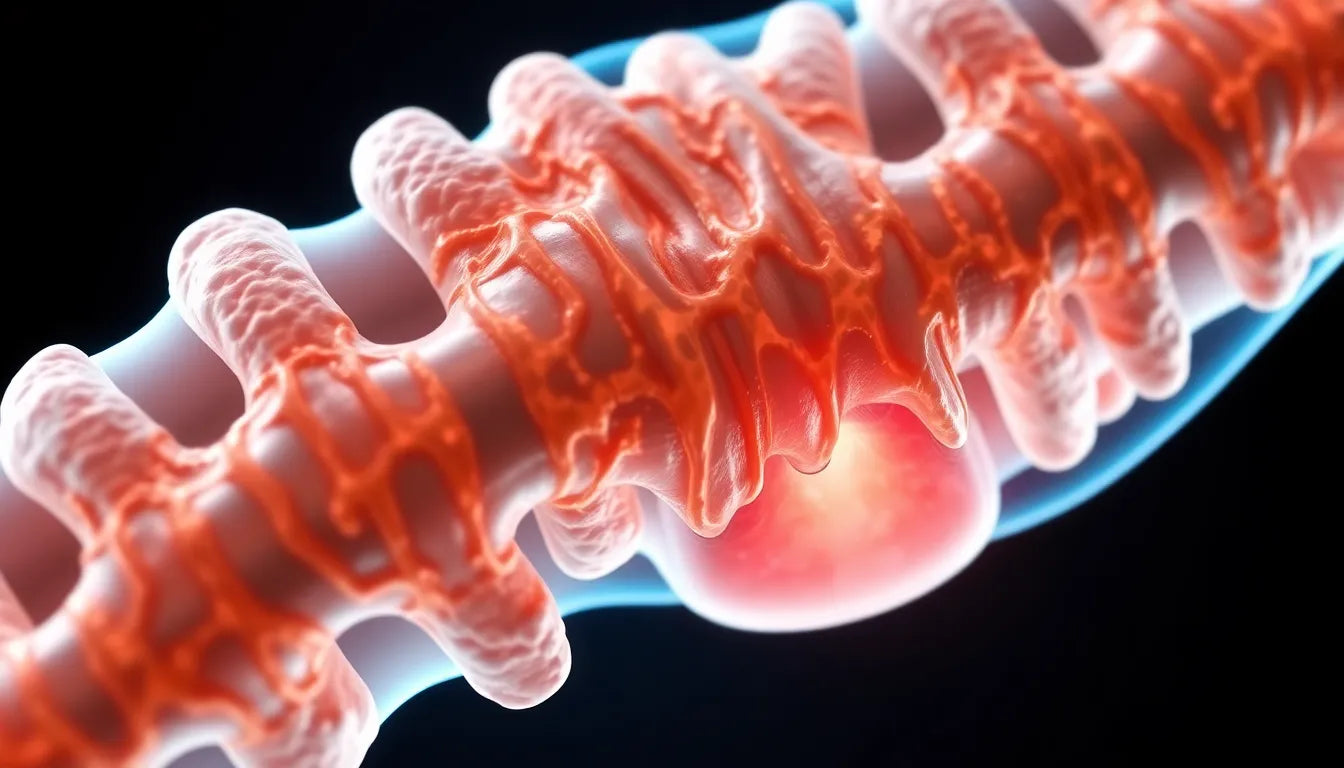Living with a thoracic herniated disc can be a daily challenge, especially when it comes to finding comfort during sleep. Unlike cervical or lumbar herniations, which occur in the neck and lower back, a thoracic herniated disc affects the mid-back area. This condition arises when the soft inner material of a disc pushes through a tear in its tougher exterior, potentially compressing nearby nerves. The result is often pain, numbness, or discomfort that can significantly disrupt sleep quality.
Understanding thoracic herniated discs
The thoracic spine, located between the neck and lower back, is less prone to herniation compared to its cervical and lumbar counterparts due to its relative stability and support from the rib cage. However, when a herniation does occur in this region, it can lead to unique challenges. Common symptoms include sharp or burning pain in the mid-back, radiating pain along the ribs, and even tingling or numbness in the chest or abdomen. These symptoms can intensify at night, making it difficult to find a comfortable sleeping position.
The importance of sleep
Quality sleep is crucial for recovery and effective pain management. During sleep, the body undergoes essential repair processes, reducing inflammation and aiding in tissue healing. For individuals with a thoracic herniated disc, achieving restful sleep is vital to managing pain levels and improving overall well-being. Unfortunately, the discomfort associated with this condition can make it challenging to get the restorative sleep needed.
Objective of the blog post
This blog post aims to provide practical advice and strategies to enhance sleep quality for those dealing with a thoracic herniated disc. By exploring optimal sleeping positions, spinal alignment techniques, and additional tips for comfort, we hope to empower you with the tools needed to navigate the night with less pain and more rest. Stay tuned as we delve into effective methods to help you find comfort and improve your sleep despite the challenges posed by a thoracic herniated disc.
Optimal sleeping positions for thoracic herniated disc
Finding the right sleeping position is crucial for those suffering from a thoracic herniated disc. It can significantly reduce pain and improve sleep quality. For back sleepers, it's advisable to place one or two pillows under the knees. This simple adjustment helps maintain the natural curve of the spine, alleviating pressure on the herniated disc. Additionally, using a medium-thick pillow under the head ensures the neck remains in a neutral position, preventing strain.
For those who prefer side sleeping, keeping the spine aligned is key. Placing a pillow between the knees can help achieve this alignment, reducing stress on the thoracic region. It's important to avoid curling the body too much, as bending the head down towards the knees can exacerbate pressure on the spine.
Spinal alignment and support
Maintaining proper spinal alignment is essential in managing symptoms of a thoracic herniated disc. One effective strategy is to use a rolled-up towel or piece of foam under the lower back. This support can help adjust spinal alignment, promoting decompression of the spine and reducing pain. Ensuring the head and neck are supported with an appropriately sized pillow is also crucial. This prevents unnecessary strain on the cervical spine, which can lead to additional discomfort.
Avoiding stomach sleeping
Stomach sleeping is generally discouraged for those with a thoracic herniated disc. This position can strain the neck and lower back, potentially worsening symptoms. The unnatural curvature of the spine in this position can lead to increased pressure on the herniated disc, making it harder to find relief from pain. Instead, focusing on back or side sleeping positions can provide better support and alignment, contributing to a more restful sleep.
Additional tips for better sleep
Beyond adjusting sleeping positions, there are several other strategies to enhance sleep quality. Consider investing in ergonomic aids such as adjustable beds or specialized pillows designed to support spinal health. These tools can offer additional comfort and adaptability, making it easier to find a pain-free sleeping position.
Incorporating relaxation techniques into your bedtime routine can also be beneficial. Practices like deep breathing exercises or meditation can help calm the mind and body, promoting a more peaceful and restorative sleep. Creating a relaxing sleep environment with dim lighting and a comfortable mattress can further enhance the quality of rest.
By implementing these strategies, individuals with a thoracic herniated disc can improve their sleep quality, managing pain more effectively and enhancing overall well-being. These adjustments, though simple, can make a significant difference in navigating the challenges of sleeping with this condition.
Lifestyle adjustments for better sleep
For those dealing with a thoracic herniated disc, incorporating lifestyle adjustments can significantly enhance sleep quality. One key factor is maintaining a consistent sleep schedule. Going to bed and waking up at the same time each day helps regulate the body's internal clock, promoting more restful sleep. Additionally, creating a restful sleep environment is crucial. This involves ensuring a dark, quiet, and cool bedroom, free from distractions such as electronic devices.
Engaging in gentle stretching or low-impact exercises can also be beneficial. These activities help alleviate tension, improve flexibility, and reduce pain, making it easier to find a comfortable sleeping position. However, it's important to avoid vigorous exercise close to bedtime, as it may interfere with the ability to fall asleep.
Diet and hydration
A balanced diet and proper hydration play a vital role in managing inflammation and supporting overall health, which can contribute to better sleep. Consuming anti-inflammatory foods, such as fruits, vegetables, whole grains, and lean proteins, can help reduce pain and discomfort associated with a thoracic herniated disc. Additionally, staying hydrated by drinking plenty of water throughout the day is essential, as dehydration can exacerbate muscle tension and pain.
Avoiding heavy meals, caffeine, and alcohol close to bedtime can also improve sleep quality. These substances can disrupt sleep patterns and make it more difficult to achieve restful sleep, particularly for those experiencing pain from a thoracic herniated disc.
Frequently asked questions
What is the best sleeping position for a herniated disc?
The best sleeping position for a herniated disc, particularly in the thoracic region, is typically on the back. Placing one or two pillows under the knees can help maintain the spine's natural curve and reduce pressure on the herniated disc. This position promotes spinal alignment and minimizes discomfort.
How can I relieve back pain from a herniated disc while sleeping?
To relieve back pain from a herniated disc while sleeping, consider using additional pillows for support and adjusting your sleeping posture. For back sleepers, placing pillows under the knees can help. Side sleepers should use a pillow between the knees to keep the spine aligned. These adjustments can alleviate pressure on the disc and improve comfort.
Are there any specific products that can help with sleep comfort?
Yes, several ergonomic aids can enhance sleep comfort for those with a thoracic herniated disc. Memory foam pillows, adjustable beds, and specialized mattresses designed for spinal support can provide significant relief. These products help maintain proper alignment and reduce pressure points, contributing to a more restful sleep.
Can lifestyle changes improve sleep quality with a thoracic herniated disc?
Absolutely. Consistent sleep routines, regular exercise, and relaxation techniques can positively impact sleep quality for individuals with a thoracic herniated disc. These lifestyle changes promote better sleep habits, reduce stress, and alleviate pain, making it easier to achieve a good night's rest despite the challenges of a herniated disc.
By implementing these strategies and understanding the role of diet, hydration, and lifestyle adjustments, individuals can effectively manage their symptoms and improve their sleep quality, even when faced with the discomfort of a thoracic herniated disc.
Sources
- Spine-Health. (n.d.). "Herniated Thoracic Disc Symptoms and Treatment."
- WebMD. (n.d.). "Thoracic Herniated Disc."
- Verywell Health. (2021). "Understanding Thoracic Herniated Discs."
- Healthline. (n.d.). "Thoracic Herniated Disc: Symptoms, Causes, and Treatment."
- Mayo Clinic. (n.d.). "Herniated Disk: Symptoms and Causes."


















